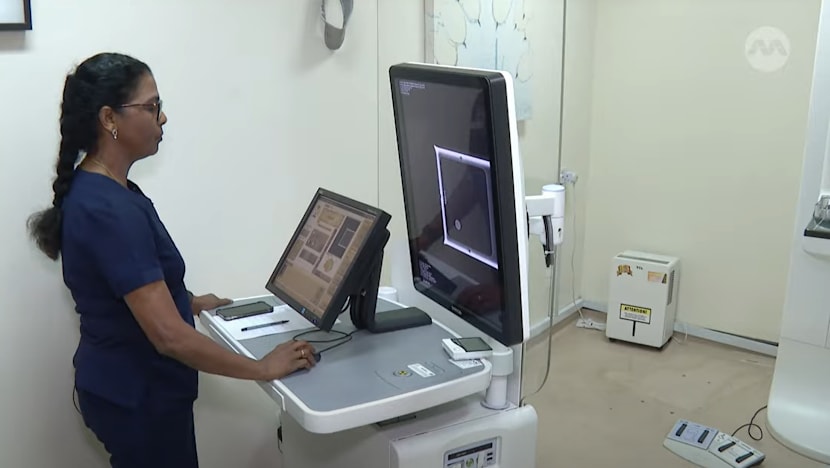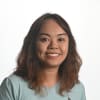How AI software in Singapore is helping to catch breast cancer before it spreads
One in 13 women are at risk of developing the disease – and the problem is worsening due to several reasons, including a more sedentary lifestyle, said one expert.

Ms Betty Matthew, senior principal radiographer and assistant director of diagnostic imaging at SATA CommHealth, using a breast cancer scanning AI software.

This audio is generated by an AI tool.
SINGAPORE: Just six months after Ms Sabrina Loi found out she had breast cancer, it progressed from stage 0 to stage 3.
She had first discovered a small lump on her right breast and decided to go for a checkup when it grew bigger.
“I found out in June, but the surgery (to remove the lump) was in November, and the biopsy result came back in December,” the 35-year-old, who is an assistant relationship manager in the finance industry, told CNA.
More bad news followed. After going into remission, she suffered a relapse when the cancer spread to her brain.
Ms Loi is still undergoing treatment. She said early detection is key to helping others manage the disease.
“Cancer is a very tricky, very aggressive kind of illness … I really don't want people to go through the stage that I've been through, going for different kinds of injections, and keep getting relapses,” she said.
“Some people can manage. Some people cannot manage,” she added.
AI SOFTWARE HELPS RADIOGRAPHERS
Experts say the use of artificial intelligence could be pivotal in detecting the disease earlier, especially as one in 10 of all breast cancer cases in Singapore are diagnosed at stage 4 – a higher rate than in other developed countries.
For instance, SATA CommHealth is using AI to equip its radiographers with a so-called “second pair of eyes” to detect breast cancer earlier and faster during mammograms – the most common screening test for the disease.
Radiographers are not just tasked to look for signs of breast cancer, but also subtle and hidden abnormalities that could signal its onset in the future.
However, microcalcifications – tiny, white deposits of calcium in breast tissue that could signal risks of breast cancer – appear as specks on a mammogram and are typically difficult to spot.
With SATA CommHealth’s AI software, a detailed report on the presence of cancer and problem areas can be produced in about less than half the time it used to take manually.
It is also around 95 per cent accurate, said Ms Betty Matthew, the charitable healthcare organisation's senior principal radiographer and assistant director of diagnostic imaging.
“Microcalcifications are very faint – they almost resemble dense breast tissue, so it is tiring for the radiologist (to spot) and there may be some chance of missing that … With AI, it will highlight them to the radiologist,” she noted.
"It’s (then) easier for the viewer to identify them, which benefits the patient because even if there is no cancer, they can say, ‘Hey, there is a chance that cancer cells may grow there, so closer follow-ups and detecting the cancer early is possible now’.”
REGULAR SELF-EXAMINATION IS KEY
Beyond advanced technology, experts said regular self-examination is ultimately key in the fight against breast cancer, which remains the most common form of cancer in the world.
But according to a new report released this month and commissioned by non-profit organisation Breast Cancer Foundation, nine in 10 young women are not taking active steps to ensure breast health.
Part of the problem is a lack of awareness of the need to screen for breast cancer, particularly among young women, said Professor Sim Yirong, senior consultant and head of the breast surgery department at Singapore General Hospital and National Cancer Centre Singapore.
One in six women in Singapore with breast cancer is aged under 45, while one in 13 women are at risk of developing the disease.
Prof Sim said the issue is worsening due to several factors, including lifestyle changes like a more sedentary lifestyle.
“The most common misconception I see is: ‘I feel fine, I don't feel a lump, I don't feel any pain. There is nothing wrong’,” Prof Sim noted.
“But that's where the screening mammogram comes in – to pick things up even before you get any symptoms, before you feel a lump, before there's any discharge.”
She said women are encouraged to examine themselves at least once a month for any signs of breast cancer, even if they are below 40 years old.
In Singapore, women between the ages of 40 and 49 are recommended to have yearly mammograms.
“You may be too young for screening mammograms (but you should) still examine your breasts regularly,” Prof Sim cautioned.
“You are the best person to know when … you have a lump in the breast or lump in the arm.”

















